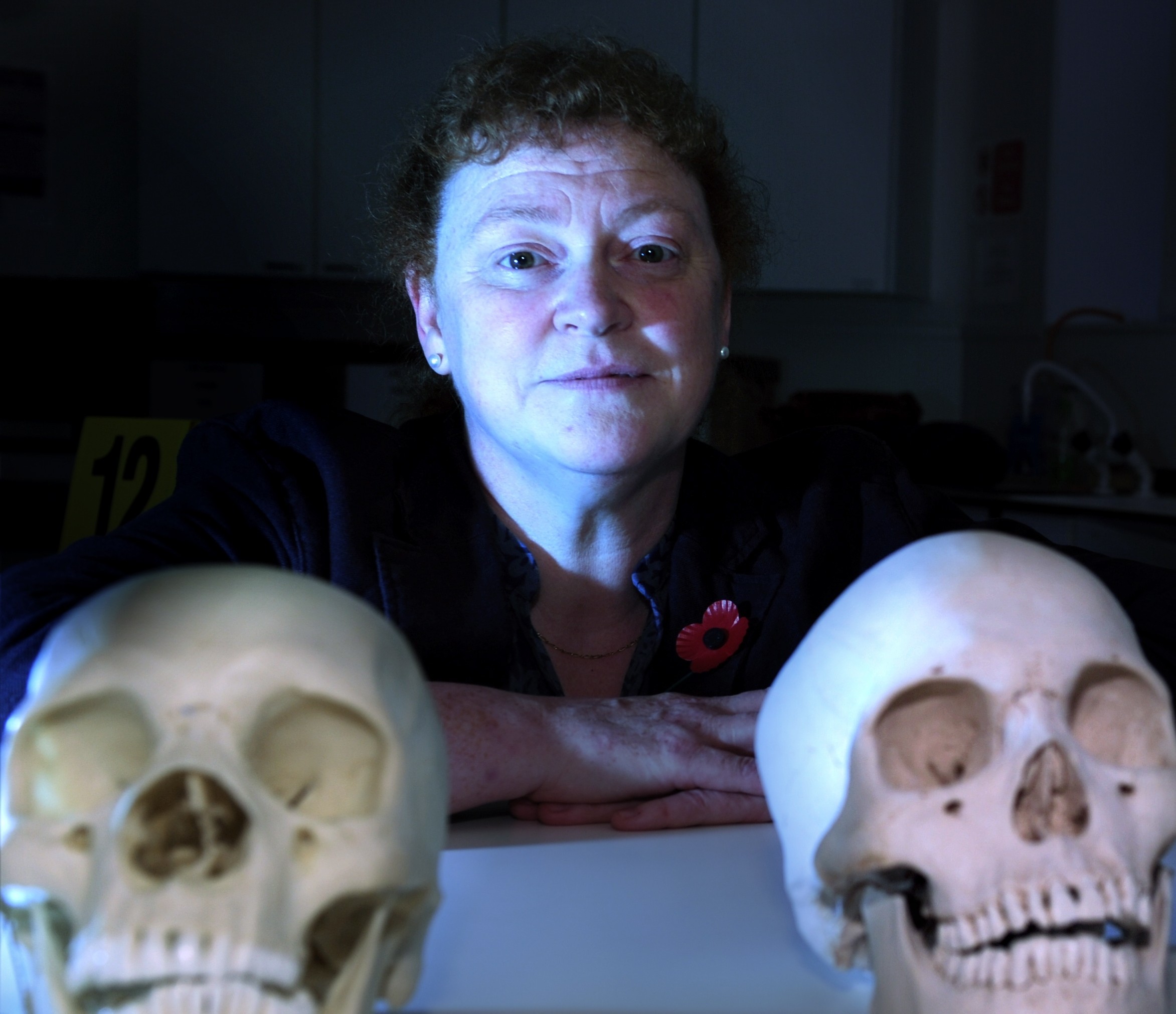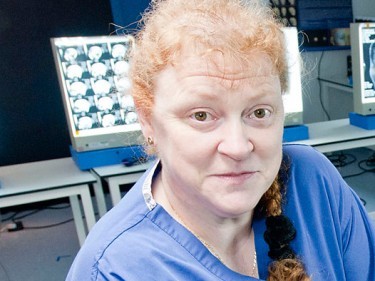It’s a sad fact that forensic science is a profession which is predicated on human misery. But by speaking for the dead, Professor Sue Black is glad to be able to do her part for the living
Last year, Professor Sue Black held her father’s hand as he took his last breath. Quietly poignant, it was a moment that deepened her already extensive relationship with death a shade further.
“It was a life-changing experience. To be there for somebody who has been there for you your entire life, and for them to share that last moment with you,” she said solemnly, seeking the words to convey the moment’s significance.
As a luminary of forensic anthropology for the past 30 years, death is nothing new for Prof Black. In her career, she has shone lights on the most grisly of crimes, from murders on British soil to the suspected systematic torture of tens of thousands of captive rebels in Syria’s current civil war.
The 53-year-old Inverness-born scientist is at the forefront of her profession, and is recognised with commensurate respect. She’s pioneered techniques of human identification which have helped in the break-up of Scotland’s largest paedophile ring; she’s aided in identifying the remains of those who died in the 2004 Indian Ocean tsunami so they could be returned to their grieving families; and she was made an OBE for her services to forensic anthropology, such as gathering evidence of war crimes in Kosovo by exhuming mass graves.
This month, a further accolade has come her way, in the form of the Andrew Fletcher of Saltoun Award in recognition of her contribution to science. The Stonehaven resident seems to approach such honours as she does her work – with pragmatism and modesty.
Similarly, in each case she tackles, from the small to the genocidal in scale, Prof Black approaches death with a level head. In fact, the passing of her father was one of the only times she could permit herself to bring emotion into the equation.
“As a child, it’s something you can do for your parent, to make sure that they don’t go out on their own, if it’s possible. And for me, it was a really defining moment. It was a privilege and an honour,” she said.
KEEPING EMOTIONS IN CHECK
Forensic science, on the other hand, has no room for emotion or sentimentality. That’s something of a motto for Prof Black and her colleagues. It’s one which they must remind themselves of continuously, not only to guard against the emotionally distressing situations they walk into, but to negate bias from the formula.
Even more so than emotion, she explained, bias definitely has no place in forensic science.
“I think in this kind of profession, you have to be very careful and look after yourself because, if you don’t, you can’t do your job. You’re going to let your team down, the government down and justice down,” she explained.
“Each time, you make the conscious decision: ‘Am I the right person for this job? Can I cope with this?’ So there’s an element of self-protectionism within that.”
The scientists must also remember that they themselves are guilt free. After all, they didn’t strangle the victim to death or sexually abuse the minor. Their responsibility in this situation is clear – to enter the scene, then collect, assess and present the evidence to those whose job it is to decide whether it is robust and credible enough to convict the accused.
But when you face some of the horrors Prof Black does on a near daily basis, it can be difficult to keep judgment at bay.
“Of course you would be a sociopath if you didn’t have any feelings or emotions at the time. You cannot do a postmortem of a two-year-old child in the middle of a field in Kosovo who has been gunned down and not think ‘the poor child, their family, the awfulness of the situation’.
“We’re human, but you have to keep it in check. It’s not appropriate for you to break down. That doesn’t mean that we’re uncaring and cold.”
STARVATION AND TORTURE
Prof Black’s mettle was taxed particularly heavily in January this year. She was flown to Qatar by a law firm especially to survey thousands of pictures of dead men. Alongside a small panel of fellow globally-renowned forensic and legal experts, she had to help verify what the Qataris believed the images to be – proof that the Syrian government has carried out thousands of brutal executions of rebels who were held in detention centres across the civil-war-torn country.
The pictures came into the possession of the Qatari firm via an individual dubbed for protection purposes as “Caesar”, who purported to have defected from his role as a Syrian military policeman. His job, he maintained, was to take photographs of the corpses of deceased torture victims.
During her time analysing approximately 23,000 images – of a total 55,000 smuggled out of Syria by Caesar – the expert panel was tasked with verifying the photographs’ credibility as evidence in a larger war crime case being mounted against Syrian president Bashar Al Assad’s regime.
While the panel was unable to verify if the men in the pictures were definitely from Syria, they could confidently state that they were indeed of thousands of individual bodies, each bearing genuine marks of torture.
Upon returning to the UK, Prof Black compared the sights of the brutalised bodies to scenes from the Holocaust. They were the most distressing images she had witnessed in her 30-year career.
“With Kosovo, we tended to be looking at gunshot injuries mostly. Although not exclusively, it’s a relatively quick death. But with these individuals, these were not quick deaths. Many were starved. And we’re not talking about people who are just thin, but starvation levels – almost skeletons with skin covering them. That doesn’t happen overnight, so that tells you that these people went through abuse for a long, long time,” she explained.
Reviewing the horrifying list of evidence, you can understand her distress. Strangulation marks around throats, tram-line beatings across their bodies most likely inflicted with plastic bars, and ulceration of the legs indicating the captives were pinned down during the torture – these are just some of the atrocities she saw.
“This was a systematic torture of people over an incredibly long period of time for some individuals,” she said.
While the report has been written and almost unilaterally upheld by members of the diplomatic community, justice isn’t just around the corner. With the situation in the Middle Eastern country becoming ever more complicated, it may be some time before the extent of these horrendous crimes is known, and their perpetrators identified.
This is, of course, frustrating to the expert panel, but as Prof Black stated throughout our interview her job is one part of a “much larger game”.
“You have no role in making somebody be found guilty or giving them a sentence. That’s the court’s job. The courts are the triers of fact.”
A HIGHLY STRESSED SCENARIO
The subject matter of her life’s work may often be bleak, gruesome and distressing, but it isn’t all dark. For starters, there’s the joy of playing a part in seeing justice served.
It’s a role which isn’t easy at the best of times, as is seen any time she takes to the stand to give expert testimony. Regular grillings from the defence has bred within her an understandable contempt for some areas of the legal profession. But with the stakes so high, she is ever mindful to present robust data which even the most persistent lawyer cannot discredit.
“It’s incredibly stressful,” she said of working on high-profile cases, “because at all times, you are conscious of, ‘I can’t make a mistake’. If you make one it’s there for the entire world to see. It’s a highly-stressed scenario, but the rewards are huge.
“And I’m not talking monetary rewards, can I just say. I wish,” she added with a laugh. Rather, the rewards are justice-based. An excellent example is in the work she does with paedophilia cases. By isolating distinctive patterns of knuckles and other areas of skin, she and her colleagues have been able to present powerful evidence against accused paedophiles. Such is the strength of this method, it has resulted in a change of plea to “guilty” in nearly 82% of cases.
Where this matters most to Prof Black is that, with such a change of plea, the child victim avoids the potentially traumatic ordeal of giving evidence in court. The most precious thing, she explained, is receiving a letter from a parent thanking the scientists for helping protect their child.
“So many of these cases fall away because the victims are scared to go to court. And changing the plea means that you don’t victimise the person twice,” she said.
Outside the courtroom, there is also joy to be had in being a forensic anthropologist. For example, in her role as director of Dundee University’s Centre for Anatomy and Human Identification, Prof Black effused about educating the next generation of forensic anthropologists.
The bodies bequeathed to medical science contained in the university’s new mortuary – which she has personally championed and helped raise the £1million to build – bring an invaluable depth to the educational journey. She is ever thankful for the “wonderful educational gift” people who donate their bodies bestow on the medical profession, and it’s a message she is sure to pass on to each intake of students.
“It’s so sobering for the students. At first it’s just a dead body, but then suddenly they realise that it’s someone’s granny or granddad. And they gave their body so that they could learn. The enormity of that hits them like a juggernaut. But they shoulder that responsibility with gratitude.”
And then last, but certainly not least, Prof Black’s personal life is also a great source of comfort. The proud mother of three daughters, and a long-time wife to a “very understanding husband”, her family has always supported her and encouraged the passion she has for her career.
BEING HUMAN
Despite devoting her life to the study of death, Prof Black finds that so much of her job is dealing with the living.
Whether it’s consoling families in Kosovo or speaking with loved ones of individuals who have bequeathed their bodies to the university, her job is about being “honest, open, trustworthy and human”.
It is in acting as the bridge between the dead and those left behind, that Prof Black finds her role has its most meaning.
As she found with her father’s death, it is a privilege to play some small role in the “larger game”.
“We deal with people alive and we deal with people dead. It’s very rare that we get that honour to be at that transition between one phase and the other,” she said, reminiscing about her father.
“I mean, nurses and carers do it all the time, which are in my opinion the most amazingly important jobs. It’s an honour and a privilege to be there with somebody when that crossover happens.”

